If your employees keep falling short of your expectations, you’re probably not great at communicating them. But, don’t worry — this can change with a bit of practice and consideration!
In this article, we’ll review the benefits of setting expectations in the workplace, explore different types of expectations, and teach you how to become better at setting clear requirements for your employees.
Let’s dive in!
Table of Contents
Why are expectations important in the workplace?
Setting expectations with your team is crucial if you want to create an environment of accountability and trust in the workplace.
Let’s take a closer look at its benefits.
👉 Clear expectations eliminate ambiguity
People can’t read minds. Employees can’t know what you expect of them if you don’t communicate it clearly.
Don’t assume anything is self-evident. After all, something that’s undoubtedly red to you could be green to a color-blind person. If you think something “goes without saying”, say it anyway — just in case.
This way, you’ll dispel any ambiguity and confusion among your team and allow them to proceed with their work without wondering how to interpret your intentions for them. You can avoid many misunderstandings and expensive mistakes by communicating expectations clearly.
👉 Clear expectations give employees autonomy within a set framework
There’s immense freedom in structure. This statement might sound contradictory, but research proves creativity is at a much higher level in structured external conditions.
Clear expectations remove the cognitive load of planning off of employees’ shoulders and define the framework within which their creative play can be free.
This framework allows both you and your team to relax in the knowledge everyone is on the right track, without your having to micromanage anyone.
👉 Clear expectations release stress and boost employee satisfaction
One of the main stressors at work is not fully understanding your responsibilities and role in general.
You might have felt this kind of anxiety yourself — you have no idea what you’re doing, but you feel like you should know. Therefore, you never ask for clarification and keep pretending you’re on top of your work.
The stress around unclear expectations intensifies in the times of great changes at work. One survey has discovered that 31% of employees find unclear expectations from managers the most stressful part of a workplace change.
👉 Clear expectations increase employee engagement
According to research by Gallup, clear expectations are essential for employee engagement. The research indicates that employees whose job descriptions match the actual work they do on a daily basis are 2.5 times more likely to be engaged.
By being clear about what you want from your team, you allow them to relax and focus on the task at hand.
👉 Clear expectations improve overall team communication
Setting unambiguous expectations is good for overall team communication.
Imagine the following scenario:
John from the Customer Happiness team didn’t reach out to an angry customer because he thought it was Maya’s job to do it. Consequently, the customer has unsubscribed from their service and left a mean review.
The team lead wants to sanction John, John is angry with Maya, Maya is defensive, everyone else on the team is picking sides — chaos reigns!
The team-wide clash could have been avoided if only everyone knew what their responsibilities were.
When it’s clear what everyone’s role on the team is, the chances of miscommunication occurring are much lower.
Types of expectations for employees
Managers can set different types of expectations for employees.
They can apply to individual team members or entire teams.
Manager requirements can also relate to either the employee performance or their behavior in the workplace.
In this section, we’ll explore the basic categories of manager expectations.
Individual vs. team expectations
As a manager, it’s your job to steer your employees in the right direction, both individually and as a team. In that respect, we recognize the following types of expectations:
- Individual expectations — what you anticipate from each individual team member.
- Team expectations — what you require from your team as a whole.
🔸 Individual expectations example
Mark is a new addition to the design team, and the manager wants him to take charge of all the charts. So, whenever he encounters a chart-related task in their PM software, he takes it on.
🔸 Team expectations example
The manager wants her marketing team to design a product launch campaign for the company’s upcoming product. She assigns clear roles and responsibilities on the project, with some team members working on targeting the right audience, others on copy or creating a social media buzz, etc.
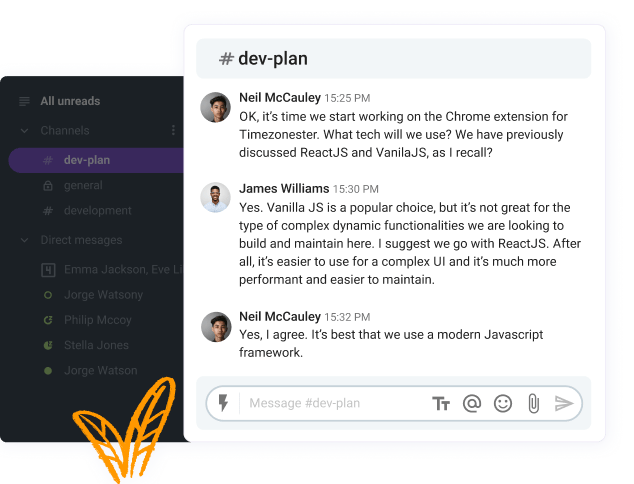
—
Great managers consider both individual and team capacities and capabilities before assigning responsibilities.
They need to take into account both individual strengths and weaknesses and team dynamics. Failure to do either can be fatal for the project’s success.
Both of the above-listed examples of individual and team expectations represent performance-based expectations.
However, managers can also require certain behaviors of their team to align with the company values. These are behavioral expectations.
Let’s break down the two categories.
Performance expectations
Performance-based expectations refer to the job requirements, tasks, and responsibilities of each person in a team.
They are much more than a simple job description — each employee needs to understand the specifics of their work (e.g. what they need to do, what tools they should use, etc.). But they also need to know how their role fits into the big picture (i.e. how it links to the overall department and company objectives).
The three elements that constitute clear performance expectations are the following:
- SMART (Specific, Measurable, Attainable, Relevant, Timely) objectives (What needs to be done)
- Rationale (Why it needs to be done)
- Actions (How it needs to be done)
We’ll explain each of the elements in greater detail through an example of a specific performance expectation.
🔸 Example of a performance expectation
- The SMART objective for the sales team: Bring the closing ratio from 35% to 40% by the end of the first half of the fiscal year.
- Rationale: Improving the efficiency of the sales department and increasing profit
- Actions:
- Personalize the sales pitch follow-up strategy.
- Research alternatives for the sales engagement platform currently in use and implement a better solution.
- Review and improve lead qualification criteria.
- Reach out to happy customers for customer success stories.
As you can see, this sales team performance expectation is clear and detailed, with little room for misinterpretation. It is based on data, and it specifies the quantitative results the team needs to achieve.
The reasoning behind the objective is straightforward, which helps employees understand why they are striving toward it.
Finally, employees are familiar with the specific actions they should take on their way to fulfilling the set requirement.
This is an example of a team performance expectation — which can further be broken down into individual roles of team members.
Behavioral expectations
As the name suggests, behavioral expectations are norms around employee behaviors and values they are expected to fulfil.
These expectations primarily ensure that employees are a cultural fit within the organization and that they successfully collaborate with their team.
No matter how good someone is at their job, it’s no use if their behavior is off.
Behavioral expectations are usually simpler and more straightforward than performance-based ones. They read as direct instructions to follow to do the best job possible.
Some of the most important behavioral expectations in the workplace are centered around time, communication, and culture.
⏱️ Time-based behavioral expectations in the workplace
The emergence of a great number of remote and hybrid work models has also popularized flexible work hours. An increasing number of employees can now work on their preferred schedule. That’s exactly why it’s essential to set time-based expectations so that everyone knows when they can reach out to each other.
Requirements for employees regarding time are especially important in teams where individual schedules differ wildly, such as in those working across different time zones. These rules allow everyone to stay in the loop, not miss anything important, and not have to be bothered in their off-hours.
🔸 Time expectation examples
- Finish your tasks within the designated deadlines.
- Always show up at check-in meetings on time.
- Respect the prescribed response times in various team channels (e.g. a day for emails, within an hour in the team collaboration app)
- Be available in the team chat app during all your scheduled hours.
- Schedule absences longer than 4 days two weeks in advance.
💬 Communication-based behavioral expectations in the workplace
Great communication is key to successful team operations — so, it’s important to establish clear communication expectations in the workplace.
These rules might outline how, when, where, and with whom employees can communicate about certain topics.
Clear communication standards are especially vital for remote teams, who don’t share the same physical location. They have to be careful about how they communicate and always work on boosting their messaging skills — otherwise, they’ll have a problem getting their message through.
🔸 Communication expectation examples
- Use the team chat app for real-time communication with coworkers.
- Use a company wiki to find information about company procedures and policies.
- Use the suggestion form provided by the manager to offer suggestions and ideas.
- Respect your coworkers’ and managers’ availability status in the team chat app.
- Use email for formal requests.
- Communicate your task progress in the team’s project management software.
💡 Pumble pro tip
You can formalize your communication expectations and put them in writing by creating an internal communication plan. Check out the instructions and templates for the plan in our knowledge hub:
🤝 Culture-based behavioral expectations in the workplace
Workplace culture should not be treated as a mere summary of some abstract values the company supports. It’s much more than that — it’s those values, shared beliefs, and attitudes put into action.
In other words, organizational culture is embodied in employees’ behaviors. As a manager, you want your team to act in accordance with your shared values. Thus, you might have certain cultural expectations of your employees.
🔸 Examples of culture-based behavioral expectations
- Be accountable for your work, as well as your mistakes.
- Respect your team members, and be sensitive to their needs.
- Ask for help when you need it.
- Be open to giving and receiving feedback.
- Prioritize your team’s success over your personal achievements.
- Be assertive in communication with your team.
How do you set clear expectations for employees?
It’s evident employees thrive when they understand what is required of them — regardless of the type of expectations in question.
To set those requirements straight, it’s best to follow the steps we’ll outline below.
1️⃣ Determine your expectations
Before you even begin to communicate your expectations to your team, you need to be clear about them yourself. In other words, you need to set specific requirements that employees won’t find confusing.
If you yourself are not quite sure about what exactly you want, how can you relay the information to your team and expect them to grasp it?
As mentioned above, always try to use the SMART approach to determining expectations. The better you can define the requirement to yourself, the better you’ll be able to convey it to others.
🔸 Example for determining your expectations
You need to assign a new project to your team. Instead of just handing it over to them with no instructions, you take the time to consider:
- a realistic deadline,
- who should work on what,
- how the project should unfold, and
- other details.
2️⃣ Break down expectations into action items
It’s not enough to expect your employees to do a great job.
What does a great job mean?
What exactly does a job well-done look like for each individual on your team?
How can they strive toward it?
What are the steps they can take to achieve it?
Of course, this does not mean that you have to lay out every detail of how each task should be done. Breaking down expectations merely means providing general instructions or steps, which are clear enough to help employees understand what you want of them.
🔸 Example of breaking down expectations
You want an employee to design an infographic for a blog post. You outline the steps she should follow in your PM software:
- Consult the writer of the blog on the details to include in the infographic
- Design and put the first draft up for review by a senior designer
- Revise accordingly and do a final checkup with the writer
- Post the final version on the team design platform
3️⃣ Explain the reasoning behind your expectations
Once you’ve laid out the what and how, it’s time to explain the why.
Studies show that employees are much more engaged if they find meaning in their day-to-day work. You need to show them why it’s important that they do what you expect of them.
Start by explaining how their role on a project contributes toward a larger goal of completing the project. But also help them understand why their work is important in a larger context — how it supports the company’s mission and vision.
Understanding the reasoning behind a task will give employees an extra boost to put effort and thought into it.
🔸 Example of explaining the reasoning behind your expectations
When setting behavioral expectations for your support agents — e.g. how they should communicate with customers and prospects — you don’t just provide instructions. You explain how the support agent role is essential for building a great reputation for the company, as they are in direct contact with the customer, and they affect how the customer perceives the company.
4️⃣ Overcommunicate
If you have a history of frustration over your employees’ not understanding your instructions, you’re probably doing something wrong. Employees missing vital information and misunderstanding expectations may mean you’re not making yourself as clear as you may think.
Don’t be afraid to overcommunicate what you expect of your team.
This doesn’t imply you should spell it out for them — but don’t shy away from repeating the message several times.
If you want your team to have the necessary information on hand at all times, you can make it available on multiple team channels of communication.
🔸 Example of overcommunication
You have a new set of rules for how social media managers should run your organization’s social media channels.
First, you announce the news during your weekly stand-up.
Then, you create a document with the instructions and post it on your wiki.
You also post the new instructions in the relevant channel of your team chat app and pin them so they don’t get lost in the general discussion.
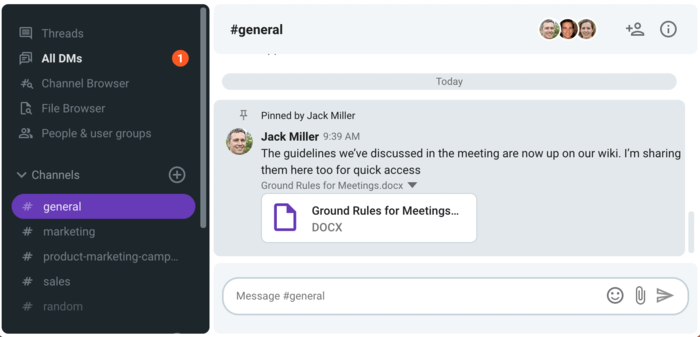
5️⃣ Personalize
One of the essential communication skills of effective leaders is actively listening to your team members’ needs and responding to them.
While thinking of the best way to set and communicate your expectations, you should consider the individual needs and strengths of your employees. This will help you determine the best role for each team member, as well as the best ways to communicate it to them.
As a manager, you should be aware of how your subordinates function and understand that not everyone responds best to the same communication style.
🔸 Example of personalization
You want a developer to build a new feature for one of your apps. As his manager, you know him to be a functional thinker and communicator — so you go straight to the point and provide him with a detailed design document without much introductory talk.
The document details the user scenarios, integration and architecture data, dependencies, and all other information that’s relevant for the process.
6️⃣ Provide resources
You can’t count on employees fulfilling their tasks if you don’t provide them with the necessary resources. This step is especially critical when delegating responsibilities to new hires, as they may not be aware of all the company resources they have at hand.
When communicating tasks to them, make sure to include links to internal materials they may find useful, as well as any links to websites that may come in handy.
🔸 Example of providing resources
A new remote writer on your team is working on her first blog post. You DM her in your team collaboration app to ask her if she needs any help and provide her with the links that might help her in her research.
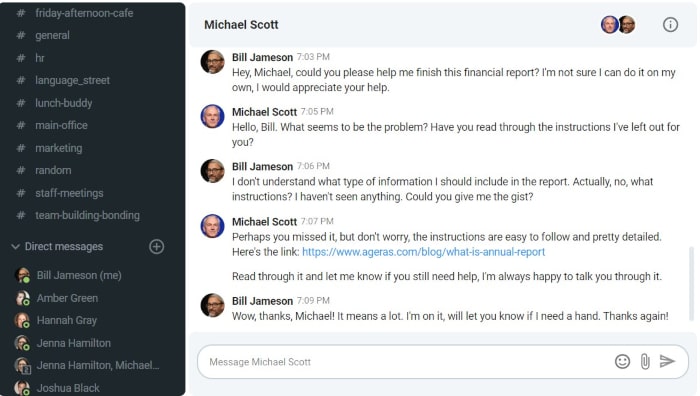
7️⃣ Involve employees in the expectation-setting process
We’ve already mentioned you should consider your employees’ individual strengths when setting expectations. But you should also consider their opinions — otherwise, you risk making wrong assumptions about their work styles and capabilities.
Involving employees in the process of setting goals and expectations creates a sense of accountability and motivates them to do their best. Research shows that employees who work at high-involvement organizations are much more engaged than those in low-involvement environments.
Just like every other process in your team, setting expectations should also be a collaborative effort — at least to an extent.
🔸 Example of involving employees in the expectation-setting process
You organize a video brainstorming session with your remote team to figure out how best to approach a critical project that will greatly impact the future of your organization.
Different team members pitch ideas and offer to work on parts of the project for which they believe their skills and experience best qualify them.
When the session is done, you review the recording of the meeting.
You carefully prepare a plan of action relying on the ideas you’ve come up with together and try to be mindful about the roles you assign, based on the tasks the team members signed up for.
8️⃣ Verify that everyone has understood what you expect of them
Sometimes, managers and employees believe they are on the same page when they are not even in the same book. You may believe you understood each other, only to find out that you didn’t when the damage is already done.
When you’re not sure you’ve been clear, it’s best to ask everyone to repeat what they’ve understood they should do. This step is particularly beneficial when the instructions are complex or out of the ordinary.
🔸 Example of verifying that employees have understood the expectations
You’ve decided to take a different approach to a new marketing strategy because the old one produced poor results. You gather your marketing team in the conference room to discuss everyone’s new roles and tasks.
At the end of the meeting, you ask team members to take turns briefly outlining their roles in the campaign. This way, you can determine if anything needs further clarification.
9️⃣ Communicate often and regularly
Setting expectations is not a matter of one and done. If you lay down the requirements and check in the next time when the employee fulfills it, you may get an unpleasant surprise.
Many things can happen in the meantime, such as:
- Employees misunderstanding the objective and failing the task
- Employees struggling due to unclear expectations
- Workplace conflict due to unclear employee roles
That’s why it’s imperative that you regularly check in on your team to see how they’re doing and if they’re on the right track.
🔸 Example of communicating regularly and often
You’ve tasked an accountant on your team with preparing a budget forecast for the upcoming year. You’ve set a deadline and established the way she should go about the task. After a while, you check in on her and review her preliminary analyses to see how she’s doing. You do this often throughout the process to make sure she’s on track.
🔟 Put everything in writing
No matter how certain you are that everyone knows what’s expected of them, you can’t be too sure until you’ve put everything in writing and shared it with the team.
By documenting your expectations, you “seal the deal” and leave no room for errors and confusion. If anyone needs to double-check what’s required of them, they can simply refer to the document.
🔸 Example of putting expectations in writing
You want your team to follow a code of conduct, which calls for them to respect each other, follow the established procedures, communicate regularly, and more. You outline the preferred behaviors, as well as those not welcome in your team, and attach the file in your team channel in Pumble.
—
Making a list of behavioral expectations is pretty straightforward. But if you need some help to put your performance-based expectations in writing, here’s a handy manager expectations template:
⬇️ Setting expectations with employees template
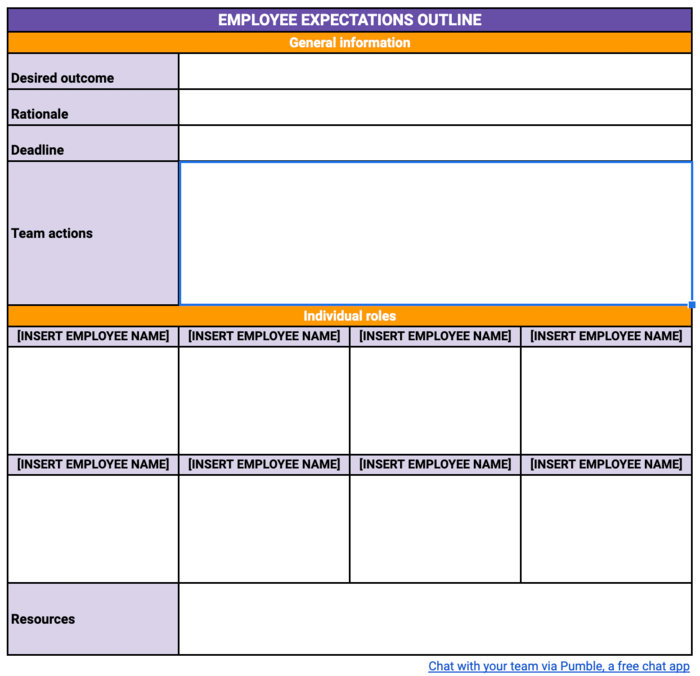
Pumble helps managers communicate expectations clearly
With Pumble, you have many channels of communication at your fingertips.
Hence, you can easily communicate with employees and set clear expectations.
On Pumble, you can communicate via:
- Direct messages,
- Channels, and
- Threads.
If you want to hold a virtual or audio meeting, you can do so via video and audio calls in Pumble.
Also, if you want to share your presentation and ideas with other participants in a video call, you can do so thanks to screen sharing.
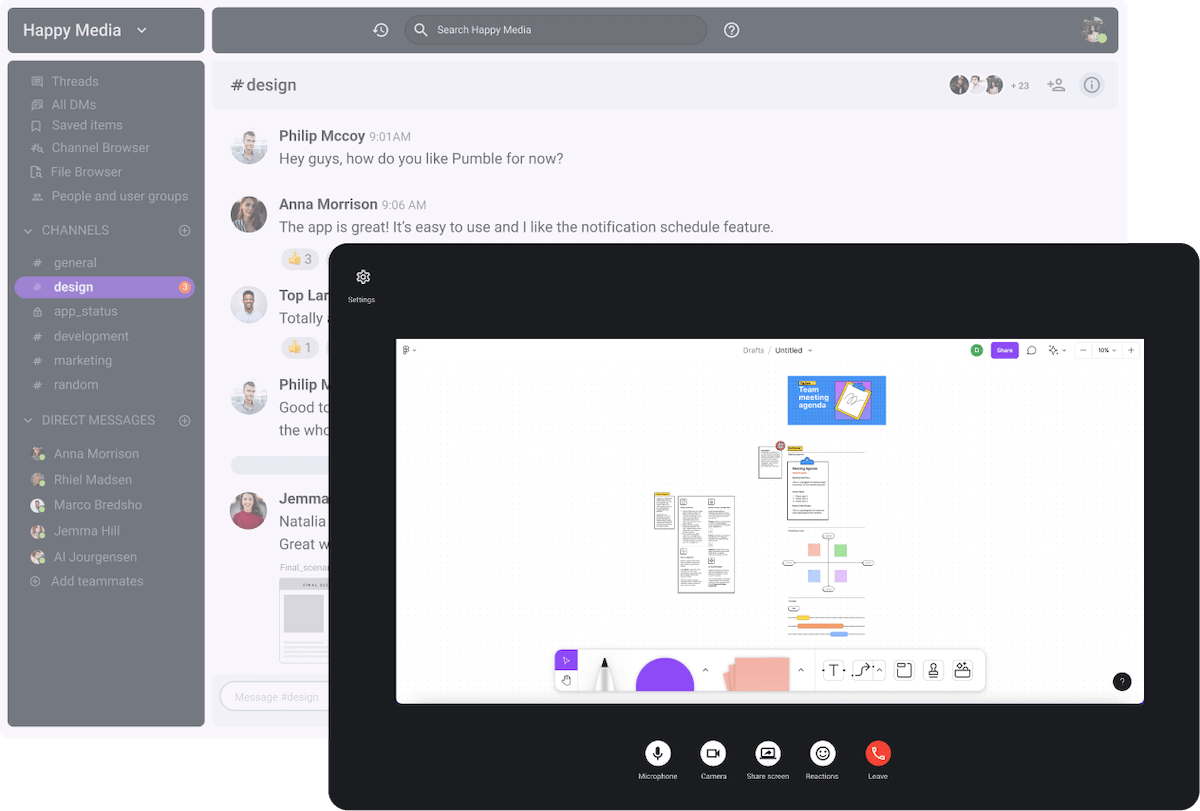
Finally, if you need to communicate expectations to your external partners, you can grant them guest access, and they can enjoy all the features as your team members.
If all these features look appealing to you, don’t waste time! Try Pumble today!




